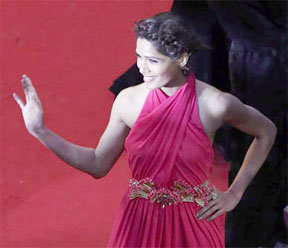CANNES, (Reuters) – Indian movie actors and a new wave of directors are on a mission at the Cannes film festival – to show that their industry, which turns 100 this year, is more than just Bollywood.

The largest Indian contingent to date is on the French Riviera at the world’s leading cinema showcase to promote the world’s biggest film industry that makes over 1,000 films a year, compared with about 600 in Hollywood.
Movies from Bollywood’s Mumbai studios and other regional films have struggled at the global box office, with Indian cinema largely dismissed as lengthy, song-and-dance numbers.
But the industry sees the 66th Cannes festival, where India is a “guest country” to mark its centenary, as a chance to showcase a new genre of Indian movies globally and to promote India as a place to both make films and win a massive audience.
“If you use the term Bollywood, it really represents the song-and-dance, credibility-stretched story kind of film,” said director Amit Kumar, whose gangster-cop thriller “Monsoon Shootout” held its premiere at Cannes yesterday.
“We need to portray Indian cinema as more international and I hope our presence at Cannes will make the world realise that Indian cinema is most than just about Bollywood,” he told Reuter
s
The Indian visitors to Cannes are also keen to lure investment to their film industry, which is forecast to grow to $5 billion by 2014 from $3.2 billion in 2010, according to a report by Ernst & Young.
India’s presence has been high-profile since the start of the 12-day festival with acting legend Amitabh Bachchan on the red carpet on opening night to mark his Hollywood debut in Baz Luhrmann’s “The Great Gatsby” alongside Leonardo DiCaprio.
Actress Vidya Balan also walked the red carpet in the pouring rain that night as one of nine members of a jury led by U.S. filmmaker Steven Spielberg that will decide the Palme D’Or award for best picture on the final day, May 26.
A gala dinner to mark Indian cinema’s centenary was due to be held on Sunday attended by a list of stars including actresses Aishwarya Rai Bachchan, Sonam Kapoor and Freida Pinto.
There is no Indian film in either of the two main competitions at Cannes. The last Indian film to vie for the Palme D’Or was “Swaham” in 1994 while “Miss Lovely”, about the C-grade horror and porn film industry in Mumbai, competed in Un Certain Regard for emerging filmmakers in 2012.

But four Indian films will be screened – “Monsoon Shoot-out”, another thriller “Ugly”, love story “Dabba” (Lunchbox) and a tribute to the industry centenary called “Bombay Talkies” with stories by four of India’s new generation of directors.
Anupama Chopra, Bolly-wood author, columnist and critic, said Bollywood was a tag that independent film-makers had to fight.
“Maybe one day (Indian filmmakers) will break free of the shackles of Bollywood and make a completely global film in terms of aesthetics,” she told Reuters.
In 2011 India saw a 42 percent jump in the number of Hollywood movies shot there, with Hollywood studios such as Disney, News Corp’s Fox, and Sony entering deals with or buying stakes in Indian companies.
There has also been a surge in the number of Hollywood movies released in India, where 3.6 billion film tickets were sold last year. Hollywood studios have been releasing their films in India simultaneously with their North American releases and also dubbing films in various regional Indian languages.
